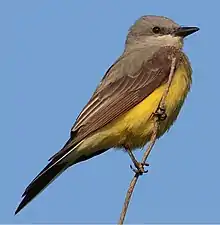| Western kingbird | |
|---|---|
 | |
| Scientific classification | |
| Domain: | Eukaryota |
| Kingdom: | Animalia |
| Phylum: | Chordata |
| Class: | Aves |
| Order: | Passeriformes |
| Family: | Tyrannidae |
| Genus: | Tyrannus |
| Species: | T. verticalis |
| Binomial name | |
| Tyrannus verticalis Say, 1822 | |
 | |
| Distribution Breeding Migration Nonbreeding | |
The western kingbird (Tyrannus verticalis) is a large tyrant flycatcher found throughout western environments of North America, as far south as Mexico.
Description
Adults are a combination of both gray and yellow plumage, along with crimson feathers that are hidden until courtship or against intruders. Characteristic of kingbird species, the western kingbird is very territorial. Although the western is often misidentified as Cassin's kingbird, Couch's kingbird, or the tropical kingbird due to the yellow coloration, it can be distinguished from these other species through its black, squared tail with white edges.
Anatomy and morphology
| Standard Measurements[2][3] | |
|---|---|
| length | 8–9.3 in (200–240 mm) |
| weight | 40 g (1.4 oz) |
| wingspan | 15.5 in (390 mm) |
| wing | 125.5–133.5 mm (4.94–5.26 in) |
| tail | 88.5–96.5 mm (3.48–3.80 in) |
| culmen | 20.5–22.5 mm (0.81–0.89 in) |
| tarsus | 18.5–19.5 mm (0.73–0.77 in) |
Distribution and habitat

The breeding habitat is open areas in western North America. The increased presence of trees throughout the Great Plains during the past century due to fire suppression and tree planting facilitated the range expansion of the western kingbird,[4][5][6] as well as range expansions of many other species of birds.[7][8][9]
Behavior
The name kingbird is derived from their "take-charge" behavior. These birds aggressively defend their territory, even against much larger birds such as hawks. They will attack humans, livestock, and pets when they think their young are in danger. Kingbirds make a sturdy cup nest in a tree or shrub, sometimes on top of a pole or other man-made structure. Three to five white, creamy, or pinkish eggs with heavy blotches of brown, black, or lavender are laid and incubated for 12 to 14 days.[10] Due to the small size of the nest, and the chicks' rapid rate of growth, most of them are pushed out of the nest, due to overcrowding, before they are fully feathered and able to fly. [2]
They wait on an open perch and fly out to catch insects such as bees, robber flies, winged ants, grasshoppers, and spiders. They are also known to eat berries, buckthorn/sumac, and poison ivy seeds.[11]
These birds migrate in flocks to Florida and the Pacific coast of southern Mexico and Central America.
Sound
The song is a squeaky chatter, sometimes compared to a squeaky toy. The call is a sharp loud whit. It occasionally sings before sunrise.
References
- ↑ BirdLife International (2016). "Tyrannus verticalis". IUCN Red List of Threatened Species. 2016: e.T22700497A93780166. doi:10.2305/IUCN.UK.2016-3.RLTS.T22700497A93780166.en. Retrieved 13 November 2021.
- 1 2 Godfrey, W. Earl (1966). The Birds of Canada. Ottawa: National Museum of Canada. pp. 249–250.
- ↑ Sibley, David Allen (2000). The Sibley Guide to Birds. New York: Knopf. pp. 336–337. ISBN 0-679-45122-6.
- ↑ Ellis, E. and R. Kannan, 2004. The Western Kingbird (Tyrannus verticalis): a recently established breeding bird in Arkansas. J. Arkansas Academy Science 58: 52-59.
- ↑ Houston S. 1979. The spread of the Western Kingbird across the prairies. Blue Jay 37:149–157.
- ↑ Gamble LR, Bergin TM. 1996. Western Kingbird (Tyrannus verticalis), no. 227. In: A. Poole (ed.). The Birds of North America Online. Cornell Lab of Ornithology, Ithaca, New York
- ↑ Livezey KB. 2009a. Range expansion of Barred Owls, part I: chronology and distribution. American Midland Naturalist 161:49–56.
- ↑ Livezey KB. 2009b. Range expansion of Barred Owls, part 2: facilitating ecological changes. American Midland Naturalist 161:323–349.
- ↑ Livezey KB. 2010. Killing barred owls to help spotted owls II: implications for many other range-expanding species. Northwestern Naturalist 91:251–270.
- ↑ "Western Kingbird Life History, All About Birds, Cornell Lab of Ornithology".
- ↑ "BioKIDS - Kids' Inquiry of Diverse Species, Welcome". www.biokids.umich.edu. Retrieved 2020-11-11.
External links
- Western kingbird Species account - Cornell Lab of Ornithology
- Western kingbird - Tyrannus verticalis - USGS Patuxent Bird Identification InfoCenter
- Western kingbird attacking red tailed hawk with photo - Denver Post, 30 September 2009
- BirdLife species factsheet for Tyrannus verticalis
- "Tyrannus verticalis". Avibase.
- "Western kingbird media". Internet Bird Collection.
- Western kingbird photo gallery at VIREO (Drexel University)
- Interactive range map of Tyrannus verticalis at IUCN Red List maps
- Audio recordings of Western kingbird on Xeno-canto.
- Western kingbird Life History - All About Birds
